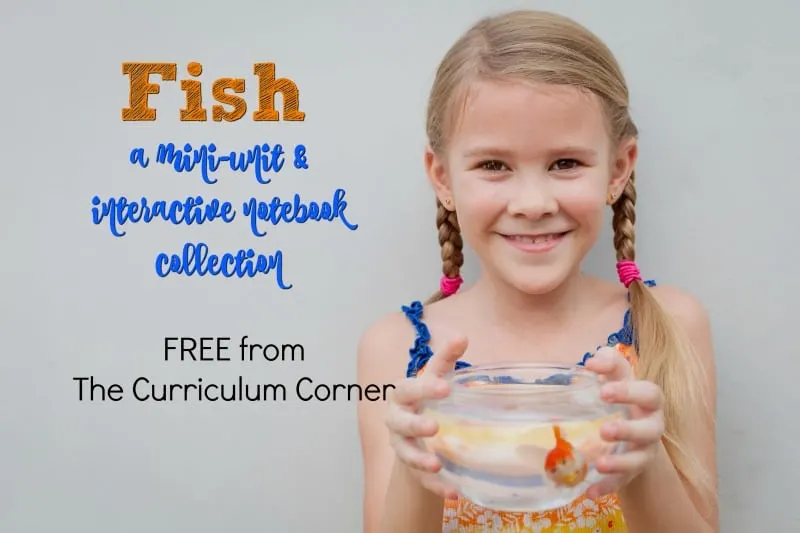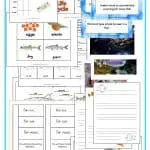This free fish unit of study contains an assortment of activities and interactive notebook pages for use in your classroom.

Some teachers choose to structure their science teaching into smaller units of study that last only a week or two while others study broader topics over a longer period of time.
For smaller units, we attempt to teach them a bit more thematically if and when possible. Regardless of how you choose to teach science concepts, we have created a variety of fish unit of study activities you can use.
Prepare Your Environment: To get started, you might want to get some things set up in your classroom. We have found that the very best way to get your students engaged in this study is to borrow or purchase some live fish and fish bowls or maybe even an aquarium. This is a great way for students to get first hand knowledge of the topic and make observational drawings & other written observations throughout the unit. We also always like to start with several baskets of books – both fiction and nonfiction – to have available for students. Grab these from your own personal library and supplement with books from the school or public library. Be sure to include picture books and/or collections of pictures of various fish (the crazier looking the better) to help create more interest.
We have a small collection of photos here: Fish Pictures.
All of this will be used as reference and enjoyment by you and the students throughout the study. You can place items on individual tables if you wish, but we have found that having a specific location in the room with all of your resources is a great way to promote student engagement.
Fish Vocabulary
Get your students familiar with the vocabulary surrounding fish with our vocabulary words and definition cards. Display these in your room, use them as a matching activity for a center or review them as a class. This post also contains some resources for assessment of these words.
Below is a description of resources we have put together to help you teach your unit. They are designed to be used as interactive notebook pages, but they can also be used independently for centers or for a science learning binder or folder for reference or study. You can download the collection at the bottom of this fish unit of study page.
Fish Information Pages – These pages contain information you can emphasize and refer to throughout the week(s) of study. You could choose to read it in a shared reading setting and include discussion with student background knowledge, or you might want to have groups or partners read the pages together and highlight important information to share.
Fish Anchor Chart – Display this in your classroom or copy and give to students a copy for their notebooks or binders.
Observations – This page can be used at various times by individual students throughout the week. It contains a place for an observational drawing and written observations of the fish. **Be sure to emphasize to your students that observational drawings don’t contain “extras” like unrelated objects in the fish bowl or aquarium. The focus of an observational drawing is the topic of study only and should contain as many drawn details as possible. One idea for these observations is to include them in your centers so that you only have a small group of students surrounding the fish at one time.
Fish Diagrams – We have provided two diagrams showing a fish’s external body parts – one with labels and one without.
Fish Foldable – This half page can be used as an open-ended assessment for students to show what they’ve learned. Students cut along the center horizontal lines and glue the left edge into the notebook. Then they lift the flaps to share what they have learned.
Life Cycle of a Salmon – These three resource pages can be used in many ways. Have your students label the parts in the life cycle of the salmon or have them use the individual pictures (provided in black & white and in color) to sequence the life cycle themselves.
Stretching Your Topic – Another way to increase engagement and help to make other subjects a little more “real world” is to think about how you can incorporate the topic of fish into other areas of your curriculum. We have found that making connections across your day can lead to increased student engagement and learning. Here are a few ideas:
READING – Gather nonfiction leveled readers for your guided reading groups and determine what aspect of informational text each group needs to focus on. Need a literacy center that mixes reading concepts with science? Try our Fishy Facts & Opinions Card Sort for one or search for another activity online that will help students to practice a skill or learn a concept while reinforcing your science topic. Have a daily read aloud time? Use this week to read various stories about fish – Rainbow Fish, The Pout Pout Fish or other well-known books. You might even think about reading a short chapter book that is about a fish in some way. A great short literary nonfiction chapter book to read aloud is The Magic School Bus: The Great Shark Escape if you want your students to learn facts as they go. (This could also be used as an enrichment book club book.)
MATH – What is your unit of study in math and how could you incorporate the study of fish into the current topic if possible? If your students are learning about linear measurement, perhaps they could research the lengths of several types of fish (including sharks) in the ocean and then use yarn or string to show the true length. If your students are learning about liquid measurement, maybe you could relate that learning to the size of fish tanks or even larger fish aquariums. If money is the topic, you could create story problems involving the costs of several kinds of fish and fish supplies in a pet store. Maybe you just have them practice their math facts using a fun game of Go Fish! (For this game use a simple set of flash cards and students ask each other for specific answers. If the other student has a math fact that equals that answer, they give it away and the first student has a match.) Want to throw in some critical thinking? Try this Fish Logic Puzzle.
WRITING – This might be a fun time to teach your students about the meaning behind the term “fish story”! As a class write a funny fish story by choosing a humorous topic and then having each student share something even more exaggerated than the student before. Or what about focusing on features of nonfiction texts such as headings, diagrams, bold words and glossaries and having students use their own learning to create nonfiction books to teach younger students about fish? Or how about having students keep journals of some kind? You can use our Lined Fish Paper for various writing activities. There are six different pages with lines for different writing purposes throughout your fish unit.
RELATED ARTS – Get your special area teachers (art, P.E., and music) involved by sending them a quick e-mail letting them know when you will be studying fish. Perhaps they might have ideas as to how they can extend the topic into their own classrooms for your students.
You can download the free interactive notebook pages for this fish unit of study below:
Interactive Notebook Resources for the Study of Fish
Here are some resources you might want to order from Amazon:
Fabulous Fishes
DK Eyewitness Books: Fish
Sharks
National Geographic Readers: Swim Fish!: Explore the Coral Reef
What’s It Like to Be a Fish? (Let’s-Read-and-Find-Out Science 1)
And here is an additional resource we found that might be helpful: Salmon Life Cycle Link


Craig Albert
Monday 1st of June 2015
Nice post